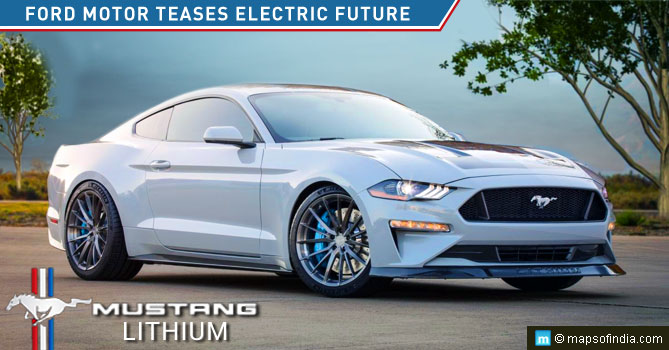
Ford Mustang “Lithium”
Legendary Automaker Ford has elaborate plans for the all-electric future. To celebrate their preparedness, they’ve electrified their iconic pony car. An all-electric Ford mustang with a six-speed manual transmission is under works, and it’s mean of Ford not to put it into production immediately. The company has planned this one-off build as a means of testing its battery and thermal management technology. Ford is working alongside Webasto, for the expanding electric market.
The car walked away with laurels at the Specialty Equipment Market Association (SEMA) trade show held in Las Vegas between the 5th and 9th of November. It is badged the Mustang Lithium and features a Phi-Power dual-core electric motor with twin power inverters, fueled by an 800-volt battery designed by Webasto. The setup produces 990-HP at 1350 Nm of torque, doing full justice to the steed’s muscle car image. The car also features custom-built carbon fibre body components, twenty-inch staggered-fit forged wheels. The Mustang Lithium’s body stance is lower by an inch.
The six-speed manual transmission provides for a little performance transmission anarchy and will be loved by those who believe in three pedals. For the performance-driven experience, an electric sports car with a manual shift stick makes complete sense.
Most production-spec electric cars have 400-volt battery packs which provide standard passenger car output and driving range. Other than the recently launched Porsche Taycan, the Mustang Lithium is the only car with a system voltage of 800 volts. Remember, we are talking about sports car territory. In this category, by going extra million miles, one can harness electric power for thrills.
The 800-volt battery system is also worth noting. The Porsche Taycan is considered the first production vehicle equipped with a system voltage of 800 volts as opposed to the usual 400 volts found in most electric cars.
The purpose of the introduction of this high power battery unit is to give us a glimpse into Ford’s plans for its upcoming range of production electric vehicles. Ford has attempted to establish that a robust electrical system should accommodate super-fast charging. The Taycan’s 800-volt system allows it a boost from 5% battery life to 80% in just a little over twenty minutes, with a max charge intensity of two hundred and seventy kilo-watts.
The car gets four driving modes, namely Valet, Sport, Track and Beast, to allow flexibility of torque application and control while driving under different conditions. While sport, track, and beast are quite obvious, valet is in case the owner has to hand the keys to someone else. The mode takes all the power and aggression out of the equation leaving only the parking feature active. Though the displacement range on a full charge is not known, people got a brief glimpse of a dashboard-mounted 10.4-inch touchscreen infotainment unit.
Ford has always acknowledged and shown support for hybrid vehicles; their primary goal has been the development of production-spec electrics. The company declared an 11 billion dollar investment plan to build a portfolio of sixteen purely electric vehicles in addition to its range of forty hybrids, by the year 2022. Ford’s electric-car range will include a brand new fully electric SUV inspired by the Mustang Lithium, along with an all-electric version of its flagship pickup – the F150.
The teaser for the electric SUV has already been dropped and is expected to make its debut this November 17, at the 2019 Los Angeles motor show. Built to take on the likes of the Tesla Model Y, Ford’s new electric will be something between an SUV and a crossover. The electric SUV is yet to be named; it will possibly be called the Mach E.
The front fascia, the bold character and shoulder lines, the triple slat tail lights are all likely to be inspired by the iconic sports car. The electric SUV is under development on Ford’s brand new platform which supports two-wheel and all-wheel drive placement and function. Also, the flexible platform will also be designed to accommodate drive trains ranging between hybrid, plug-in hybrid, and fully electric.
Information on the electric SUV is sparse, but the company hints at a range of almost six hundred kilometres on a full charge. These figures are enough to leave the likes of Tesla Model X and Jaguar’s i-Pace electric SUV far behind. The company also hints at a smaller battery pack, lower range version of the Mustang-inspired electric SUV and will aim at developed markets to begin with.
Complete details will be released at the vehicle’s launch and will possibly include package drawings and basic schematics of the powertrain and battery placements. One can expect the Mustang-based crossover to create a true benchmark for the segment and inspire phenomenal game-changing developments in rival offerings.





